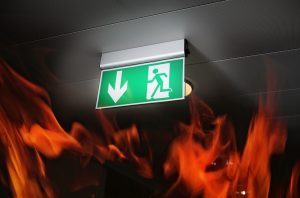Back to Basics is a weekly feature that highlights important but possibly overlooked information that any EHS professional should know. To mark Fire Prevention Week, we examine how to train workers about fire hazards in the workplace.
When it comes to workplace safety, it doesn’t get more basic than fire safety. That said, it’s never a bad idea to make sure your staff is trained on how to spot fire hazards and what they should do in a fire emergency.
The Occupational Health and Safety Administration (OSHA) provides plenty of tips and resources on workplace fire safety. OSHA also details some of its fire safety requirements in a fact sheet:
- Workplaces must have enough exits located so that everyone can get out of the facility quickly. Consider the type of structure, the number of people exposed, the available fire protection, the type of industry involved, and the height and construction type of the building. Exit doors must not be blocked or locked when employees are inside. Delayed opening of exit doors is permitted when an approved alarm system is integrated into the design of the exit door. Exit routes must be free of obstructions and properly marked with exit signs. See 29 CFR Part 1910.36 for more information.
- Employers do not have to provide portable fire extinguishers, but if they do, they must educate workers on the general principles of fire extinguisher use. See 29 CFR Part 1910 Subpart L for more information.
- Not all employers are required to have an emergency action plan. OSHA standards that require such plans include:
- Process Safety Management of Highly Hazardous Chemicals – 1910.119
- Fixed Extinguishing Systems, General – 1910.160
- Fire Detection Systems – 1910.164
- Grain Handling – 1910.272
- Ethylene Oxide – 1910.1047
- Methylenedianiline – 1910.1050
- 1, 3 Butadiene – 1910.1051
- Fixed extinguishing systems throughout the workplace are reliable firefighting tools. The systems detect fires, sound an alarm, and apply water or another extinguishing agent to suppress the fire. OSHA standards require that employers that have fixed extinguishing systems must provide a temporary fire watch of trained employees to respond to fire emergencies when a fire suppression system is out of service. The fire watch must be included in the fire prevention plan and the emergency action plan. Signs must be posted for systems that use gaseous agents (e.g., carbon dioxide, clean agents, etc.) posing a serious health hazard.
Emergency plan requirements
When required, OSHA says, employers must develop an emergency action plan that does the following:
- Describes the routes for workers to use and procedures to follow
- Accounts for all evacuated employees
- Remains available for employee review
- Includes procedures for evacuating disabled employees
- Covers evacuation for employees who stay behind to shut down critical plant equipment
- Includes preferred means of alerting employees to a fire emergency
- Provides an employee alarm system throughout the workplace
- Requires an alarm system that includes voice communication or sound signals such as bells, whistles, or horns
- Makes the evacuation signal known to employees
- Ensures that emergency training is provided
- Requires employer review of the plan with new employees and with all employees whenever the plan is changed

